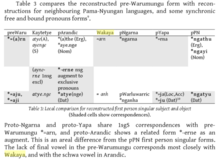Wagaya language
Wagaya (Wakaya) is an extinct Australian Aboriginal language of Queensland. Yindjilandji (Indjilandji) may have been a separate language.[4]
| Wagaya | |
|---|---|
| Ngarru | |
| Region | Northern Territory |
| Ethnicity | Wagaya, Yindjilandji |
| Extinct | (date missing) |
Pama–Nyungan
| |
| Dialects |
|
| Language codes | |
| ISO 639-3 | Either:wga – Wagayayil – Yindjilandji |
| Glottolog | ngar1291 Ngarru / Wagaya-Yindjilandji[1]bula1255 Bularnu[2] |
| AIATSIS[3] | C16 Wakaya, G12.1 Bularnu, G14 Indjilandji |
Classification
Pama-Nyungan, Warluwaric, Australian, Pama-Nyungan, Wagaya-Warluwaric, Warluwara-Thawa, Ngarna, Southern Ngarna, Ngarru
Endangeredlanguages.com also classifies Wakaya as just Pama-Nyungan and Warluwaric, but Ethnologue.com classifies the language as Pama-Nyungan and more specifically Wagaya-Warluwaric and WarluwaraThawa. While Glottolog also classifies Wakaya as Pama-Nyungan for the most-encompassing family classification, the site classifies the language under Ngarna, specifically Southern Ngarna and under Ngarru.
Sounds
Wakaya consonants [5]
| Bilabial | Velar | Alveolar | Retroflex | Dental | Lamino-alveolar | |
|---|---|---|---|---|---|---|
| Stop | p | k | t | rt | th | j |
| Nasal | m | ng | n | rn | nh | ny |
| Lateral | l | rl | lh | ly | ||
| Flap | rr | |||||
| Glide | w | r | y |
Wakaya vowels [5]
| Front | Back | ||
|---|---|---|---|
| High | i, i: | u, u: | |
| Central | e | ||
| Low | a | ||
Bularnu consonants [6]
| Bilabial | Velar | Interdental | Lamino-alveolar | Apico-alveolar | Retroflex | |
|---|---|---|---|---|---|---|
| Voiced stop | b | g | dh | dy | d | rd |
| Voiceless stop | p | k | th | ty | t | rt |
| Nasal | m | ng | nh | ny | n | rn |
| Lateral | lh | ly | l | rl | ||
| Tap | rr | |||||
| Glide | w | y | r |
Bularnu vowels [6]
| Front | Central | Back | |
|---|---|---|---|
| High | i, i: | u, u: | |
| Low | a, a: | ||
History
There are reports of around 10 Native speakers worldwide as of 1983, but the language is currently extinct.[7]
Geographic distribution
While endangeredlanguages.com reports 10 speakers of this language as of 1983, ethnologue.com explicitly states that the language is extinct.
Broadly speaking, the traditional language of Wakaya country is to the north east and east of Tennant Creek, Alyawarre is to the east and south east, Kaytetye is to the South, and Warlpiri to the west.[7]
Coordinates
Latitude: -20.33 Longitude: 137.62
Grammar

On the right is an example of the many comparisons of Wakaya grammar to other Australian languages within the same family.[8]
The Wambaya language is a neighbor of the Wakaya group and thus there are many similarities in the grammar and word structures between the two languages. A Grammar of Wambaya was written by Dr. Rachel Nordlinger in hope of helping younger Wambaya speakers learn something of their language or at least have access to there language when it is no longer being spoken around them since there were only 8 to 10 fluent speakers of the language left around the late 1990s.[9]
There are many references to Wakaya's linguistic characteristics such as its vocabulary and grammar structure and how they compare to other Australian languages within the same family group in Australian Languages: Classification and the comparative method.[10]
“The Ngumpin-YAPA Subgroup” is an article by the Australian Institute of Aboriginal and Torres Strait Islander Studies and The University of Queensland which provides shared innovations within the Ngumpin-Yapa languages such as phonological, morphological, and lexical changes. There are several common elements between the NGY and Warluwarric groups (which Wakaya is a sub-group of) and so this article presents some linguistic characteristics such as vocabulary and spelling comparisons of the Wakaya language.[11]
External links
References
- Hammarström, Harald; Forkel, Robert; Haspelmath, Martin, eds. (2017). "Ngarru". Glottolog 3.0. Jena, Germany: Max Planck Institute for the Science of Human History.
- Hammarström, Harald; Forkel, Robert; Haspelmath, Martin, eds. (2017). "Bularnu". Glottolog 3.0. Jena, Germany: Max Planck Institute for the Science of Human History.
- C16 Wakaya at the Australian Indigenous Languages Database, Australian Institute of Aboriginal and Torres Strait Islander Studies (see the info box for additional links)
- Dixon, R. M. W. (2002). Australian Languages: Their Nature and Development. Cambridge University Press. ISBN 9780521473781.
- Breen, Gavan (1974). Wakaya grammar.
- Breen, Gavan (1988). Bularnu grammar and vocabulary machine-readable files. Canberra.
- Bowern, Claire. 2011. "How Many Languages Were Spoken in Australia?", Anggarrgoon: Australian languages on the web, 23 December 2011 (corrected 6 February 2012)
- Koch, H. J., Bowern, C., Evans, B., & Miceli, L. (2008). Morphology and language history: In honour of Harold Koch. Philadelphia: John Benjamins.
- Nordlinger, R. (1998). A grammar of Wambaya: Northern Territory (Australia). Canberra: Research School of Pacific and Asian Studies, the Australian National University.
- Bowern, C., & Koch, H. J. (2004). Australian languages: Classification and the comparative method. Amsterdam: John Benjamins Pub.
- Mcconvell, P., & Laughren, M. (2004). The Ngumpin-Yapa subgroup.Classification and the Comparative Method Australian Languages Current Issues in Linguistic Theory, 151-177. doi:10.1075/cilt.249.11mcc